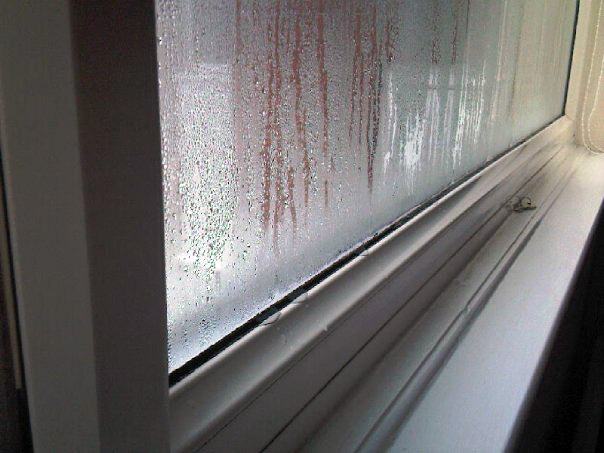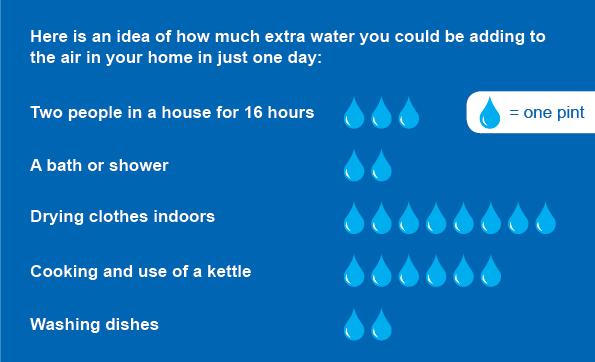Damp, mould and condensation in your home
Condensation is the most likely cause of damp and mould in our homes. It occurs mainly during cold weather, and tends to appear in places where there is poor air circulation. Because you can't see it, it's often hard to realise just how much condensation there is in your home.

Condensation on a bedroom window
[Photo: Timberwise - used under CC BY-NC-SA 2.0]
Please make sure you tell us as soon as possible if you're concerned about damp, mould or condensation in your home, especially if you think it might be having an impact on your health or the health of members of your household. You’ll need to provide us with some details and then we’ll get back to you with some next steps. You can complete our online form or alternatively we can take you through the questions over the phone - call 01494 476100. It’s important that we gather all the right information to make sure we can tackle the problem quickly, so please allow 10 minutes or so to complete the form.
How can you help improve the situation?
There is no immediate and easy solution, but as a tenant you need to balance three main factors which are heating, ventilation and moisture.
1. Heating: Ideally you should heat your whole home to around the same temperature - ideally between 18° and 21°C - so no really hot or really cold rooms.
2. Ventilation: This is essential if condensation is to be controlled - find out more on our venilation page. Here are some things you can do:
- In winter, open windows for short periods of time each day. If draughtproofing is fitted make sure there is a small space for some air to get through. If you have trickle vents fitted to the top of your window frames, leave them open.
- Open windows while cooking, after a bath or shower, or if the glass is misted up. This will let out moisture - but remember to close them again shortly afterwards so the rooms don't get too cold.
- Allow at least 5cm space between the back of furniture, such as sofas and cupboards, and the wall. It’s a good idea to check behind furniture regularly for signs of damp and mould developing.
- Try not to overfill your wardrobes, and allow space for air to circulate.
3. Moisture: Things you can do to help reduce moisture are:
- Dry your washing outside if possible. If you have to dry your washing indoors use the bathroom with an open window and the internal door shut.
- Make sure tumble dryers are properly vented to the outside of your home.
- Close bathroom doors while bathing and kitchen doors while cooking, and open a window in that room.
- Cover pans when cooking to reduce the steam given off.
- Wiping away condensation from your windows, sills and window frames each day will minimise the spread of black mould.
- If you have an extractor fan in your bathroom, always switch it on when you have a shower or a bath. If you have one in your kitchen, switch it on while cooking to help reduce moisture and cooking smells.

While condensation may not be the only cause of damp and mould in our homes, it is the easiest to manage. By making a few simple changes, you can drastically reduce the risk of mould forming in your home - taking these small steps now is a lot easier than removing it once it sets in!
This video, from DIY guru Charlie White, has plenty of advice on reducing moisture in your home, making it easier to heat and saving electricity. It explains in detail what causes condensation, how this can lead to damp and mould forming, and what you can do to prevent this. Some of the things he suggests won't be appropriate for Red Kite tenants, and some of the products he recommends are expensive to buy and run. Remember that if you're planning on making changes to your home, you must write to us and receive written permission before you start the work.
Already have mould in your home?
If you already have mould in your home, try to get it treated as soon as you can. At the first sign of mould, you should:
- Wipe down your walls and window frames with a fungicidal wash, following the instructions precisely
- Have your carpets shampooed. If you disturb mould by brushing or vacuum cleaning, you may increase the risk of being affected by the mould
- After treatment, apply a fungicidal paint directly to the wall to help prevent the mould returning. This should be applied directly to the walls, and not over ordinary paints or wallpaper
- If you're concerned about damp, mould or condensation in your home you can complete our online form or alternatively we can take you through the questions over the phone - call 01494 476100.

Mould on an interior wall
[Photo: Amanda Slater - used under CC BY-SA 2.0]
Condensation isn't the only cause of mould, so if the problem persists you should contact us so that we can carry out an inspection of your home and identify the cause. If you have any questions about damp, condensation or mould, or want to talk to someone about your home, you can contact us.
Are you struggling to heat your home?
Energy is one of the biggest expenses for many homes, but there are lots of ways we can support you - head over to our Energy saving page for information and advice, and a list of other organisations who can help.
